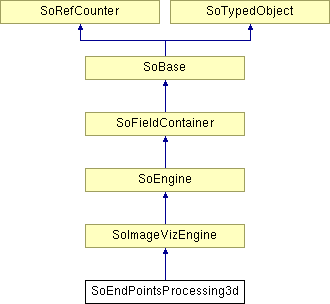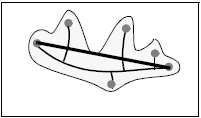SoEndPointsProcessing3d Class Reference
[Hit-Or-Miss And Skeleton]
 SoEndPointsProcessing3d image filter
More...
SoEndPointsProcessing3d image filter
More...
#include <ImageViz/Engines/MathematicalMorphology/HitOrMissAndSkeleton/SoEndPointsProcessing3d.h>

Public Member Functions | |
| SoEndPointsProcessing3d () | |
Public Attributes | |
| SoSFEnum | computeMode |
| SoSFEnum | neighborhood3d |
| SoSFImageDataAdapter | inBinaryImage |
| SoImageVizEngineOutput < SoSFImageDataAdapter, SoImageDataAdapter * > | outBinaryImage |
Detailed Description
 SoEndPointsProcessing3d image filter
SoEndPointsProcessing3d image filter
The SoEndPointsProcessing3d engine is a point detector that selects end points of a skeleton, i.e. all object voxels having only one neighbor.
For an introduction to point detectors, see section Point detectors
The skeleton is first detected, and then SoEndPointsProcessing3d performs a hit-or-miss transform (HMT) with the following rotating configuration:
![\[ \begin{array}{ccc} 0 & 0 & 0\\ \times & \bullet & \times\\ 0 & 0 & 0 \end{array} \]](form_590.png)
where  means "don't care".
means "don't care".

Skeleton and its end points
See also: SoSkeletonProcessing, SoIsolatedPointsProcessing3d.
FILE FORMAT/DEFAULT
- EndPointsProcessing3d {
| computeMode | MODE_AUTO |
| neighborhood3d | CONNECTIVITY_26 |
| inBinaryImage | NULL |
Library references: end_points3d
Constructor & Destructor Documentation
| SoEndPointsProcessing3d::SoEndPointsProcessing3d | ( | ) |
Constructor.
Member Data Documentation
Select the compute Mode (2D or 3D or AUTO) Use enum ComputeMode.
Default is MODE_AUTO
The input binary image.
Default value is NULL. Supported types include: binary color image.
In 3D configuration (see computeMode), the neighborhood connectivity defines the connectivity considered for processing adjacent voxels.
Use enum Neighborhood3d. Default is CONNECTIVITY_26.
| SoImageVizEngineOutput<SoSFImageDataAdapter,SoImageDataAdapter*> SoEndPointsProcessing3d::outBinaryImage |
The output binary image.
Default value is NULL. Supported types include: binary image.
The documentation for this class was generated from the following file:
- ImageViz/Engines/MathematicalMorphology/HitOrMissAndSkeleton/SoEndPointsProcessing3d.h